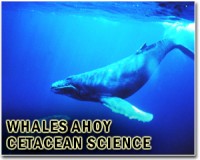 |
San Jose, Calif. (UPI) Feb 14, 2011 U.S. scientists say a 13-year-old gray whale dubbed "Flex" has been tracked by satellite in a migration that's covered more than 5,300 miles. Tagged in October in Russian waters off Sakhalin Island with a transmitter that reports his location to scientists each day, Flex was tracked past the central California coast on the weekend, the San Jose Mercury News reported Sunday. Researchers have calculated his average swimming speed at around 4 mph and say he travels about 100 miles each day. "These whales swim 24 hours a day," Bruce Mate, director of the Marine Mammal Institute at Oregon State University, said. "It's not an 8-hour shift. They don't feed during their migration, and they're really moving along." Flex is a western gray whale and with only 130 known individuals the species is second only to the North Atlantic right whale in terms of large marine mammals approaching extinction. Little is known of their behavior except that they summer off the Russian coast to feed. Flex has so far journeyed more than 5,300 miles, almost directly across deep, open ocean waters from Russia to Alaska before turning south. Though Flex is providing some first clues to the western gray's habits, researchers say they still don't know where he is going, whether long journeys such as his are normal or if he is traveling with other whales. "That's the wonderful thing about tagging studies," Mate said. "You put the instruments on the animals and they tell their own stories. They go where they go."
Share This Article With Planet Earth
Related Links Follow the Whaling Debate
 Hong Kong rare whales plan riles activists
Hong Kong rare whales plan riles activistsHong Kong (AFP) Feb 14, 2011 Beluga whales are majestic, sociable creatures that live in small pods mostly in the icy waters around the Arctic circle. They chat loudly with each other in elaborate clicks, clangs and whistles, have a big seemingly friendly smile and are, for a whale, relatively small - meaning they can be easily kept in a large tank. And that's exactly what's planned for up to a dozen of the rare ma ... read more |
|
| The content herein, unless otherwise known to be public domain, are Copyright 1995-2010 - SpaceDaily. AFP and UPI Wire Stories are copyright Agence France-Presse and United Press International. ESA Portal Reports are copyright European Space Agency. All NASA sourced material is public domain. Additional copyrights may apply in whole or part to other bona fide parties. Advertising does not imply endorsement,agreement or approval of any opinions, statements or information provided by SpaceDaily on any Web page published or hosted by SpaceDaily. Privacy Statement |